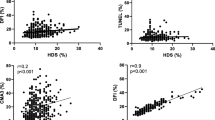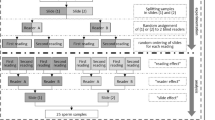Abstract
Purpose: We have previously postulated that the chromomycin A3(CMA3) fluorochrome allows an indirect visualization of sperm chromatin packaging quality and partially denatured sperm DNA. In this study we investigate the relationship between CMA3 positivity and sperm morphology. We also present data on the association between sperm morphology and the presence of endogenous nicks in sperm DNA.
Methods: Semen samples were examined from 81 males of the couples who were consulting for infertility treatment. CMA3 fluorescence was assessed for all samples, while in 24 sperm samples we also examined for the presence of endogenous nicks in the sperm DNA.
Results: When sperm morphology was less than 20% normal in a patient, the level of CMA3 fluorescence and presence of endogenous nicks were significantly higher than in patients with a higher incidence of morphologically normal sperm.
Conclusions: CMA3 could be used as an adjunct to the assessment of morphology as an evaluation method for poor sperm. Its value in predicting fertilizing ability when using either SUZI or ICSI awaits to be answered.
Similar content being viewed by others
References
Kruger TF, Acosta AA, Simmons KF, Swanson RJ, Matta JF, Oehninger S: Predictive value of abnormal sperm morphology in in vitro fertilization. Fertil Steril 1988;49:112–117
Ombelet W, Rourie F leR, Vandeput H, Bosmans E, Cox A, Janssen M, Kruger TF: Teratozoospermia and in vitro fertilization: A randomized prospective study. Hum Reprod 1994;9:1479–1484
Acosta AA, Oehninger S, Morshedi M, Swanson RJ, Scott R, Irianni F, Assisted reproduction and treatment of male factor. Obstet Gynecol Surv 1989;44:1–18
Oehninger S, Franken D, Alexander N Hodgen GD: Hemizona assays and its impact on the identification and treatment of sperm dysfunctions. Andrologia 1992;24:307–321
Oehniger S, Acosta AA, Veeck LL, Brzyski R, Kruger TF, Muasher SJ, Hodgen GD: Recurrent failure of IVF: Role of the hemizona assay in the sequential role of specific spermoocyte defects. Am J Obstet Gynecol 1991;164:1210–1215
Oehninger S, Blackmore P, Morshedi M, Sueldo C, Acosta A, Alexander NJ: Defective calcium influx and acrosome reaction (spontaneous and progesterone induced) in spermatozoa of infertile men with severe teratozospermia. Fertil Steril 1994;61:349–354
Huszar G, Vigue L, Oehninger S: Creatine kinase immunocytochemistry of human sperm-hemizona complexes: selective binding of sperm with mature creatine kinase-staining pattern. Fertil Steril 1994;61:129–135
Lui D, Elton RA, Johnstone WIH, Baker HWG: Spermatozoal nuclear chromatin condensation in vitro: A test for sperm immaturity. Comparison with results of human in vitro fertilization. Clin Reprod Fertil 1987;5:191–201
Rosenberg L, Rao KM, Bjorndal L, Kvist U, Pousette A, Ukerlof E, Fredricson B: Changes in human sperm chromatin stability during preparation for in vitro fertilization. Int J Androl 1990;13:287–296
Windt ML, De Beer PM, Franken DR, Rhemrev J, Menkveld R, Lombard CJ, Kruger TF: Sperm decondensation and semen parameters: utilization of a simple staining technique for the evaluation of human sperm decondensation. Andrologia 1994;26:67–72
Monaco PJ, Rasch EM: Differences in staining with DNA-specific fluorochromes during spermiogenesis. J Histochem Cytochem 1982;30:585
Evenson D, Darzynkiewicz Z, Jost L, Janka F, Ballachey B: Changes in accessibility of DNA to various fluorochromes during spermiogenesis. Cytometry 1986;7:45–53
Engh E, Scolberg A, Clausen OPF, Purvis K: DNA flow cytometry of sperm from normozoospermic men in barren couples and men of proven fertility. Int J Fertil 1993;38:305–310
Foresta C, Zorzi M, Rossato M, Varotto A: Sperm nuclear instability and staining with analine blue: Abnormal presence of histones in spermatozoa in infertile men. Int J Androl 1992;15:330–337
Barrera C, Mazzoli AB, Pelling C, Stockert JC: Metachromatic staining of human sperm nuclei after reduction of disulphide bonds. Acta Histochem 1993;94:141–149
Balhorn R: Mammalian protamine: Structures and molecular interactions.In Molecular Biology of Chromosome Function, KW Adolph (ed). New York-Berlin-Heidelberg, Springer Verlag, 1989, pp 366–395
Ward WS, Coffey DS: DNA packaging and organization in mammalian spermatozoa: Comparison with somatic cells. Biol Reprod 1991;44:569–574
Bianchi PG, Manicardi GC, Bizzaro D, Bianchi U, Sakkas D: Effect of deoxyribonucleic acid protamination on fluorochrome staining and in situ nick translation of murine and human mature spermatozoa. Biol Reprod 1993;49:1083–1088
Manicardi GC, Bianchi PG, Pantano S, Azzoni P, Bizzaro D, Bianchi U, Sakkas D: Presence of endogenous nicks in DNA of ejaculated human spermatozoa and its relationship to chromomycin A3 accessibility. Biol Reprod 1995;52:864–867
Sakkas D, Manicardi GC, Bianchi PG, Bizzaro D, Bianchi U: The relationship between the presence of endogenous nicks and sperm chromatin packaging in maturing and fertilizing mouse spermatozoa. Biol Reprod 1995;52:1149–1155
World Health Organization: Laboratory Manual for the Examination of Human Semen and Semen-Cervical Mucus Interaction, 3rd ed. Cambridge, Press Syndicate for the University of Cambridge, 1989
Sambrook J, Fritsch EF, Maniatis T: Molecular Cloning: A Laboratory Manual. Vol 2. Cold Spring Harbor, NY, Cold Spring Harbor Laboratory Press 1989
Sumner AT, Taggart MH, Mezzanotte R, Ferrucci L: Patterns of digestion of human chromosomes by restriction endonucleases demonstrated by in situ nick translation. Histochem J 1990;22:639–652
Kruger TF, DuToit TC, Franken DR, Acosta AA, Oehninger SC, Menkveld R: A new computerised method of reading sperm morphology (strict criteria) is as efficient as technician reading. Fertil Steril 1993;59:202–209
Eggert-Kruse W, Reimann-Andersen J, Rohr G, Pohl S, Tilgen W, Runnebaum B: Clinical relevance of sperm morphology assessment using strict criteria and relationship with spermmucus interaction in vivo and in vitro. Fertil Steril 1995;63:612–624
Aitken RJ, Clarkson JS: Significance of reactive oxygen species and antioxidants in defining the efficacy of sperm preparation techniques. J Androl 1988;9:367–376
Huszar G, Vigue L: Incomplete development of human spermatozoa is associated with increased creatine phosphokinase concentration and abnormal head morphology. Mol Reprod Dev 1993;34:292–298
Kumaroo KK, Jahnke G, Irving JL: Changes in basic chromosomal proteins during spermiogenesis in the mature rat. Arch Biochem Biophys 1975;168:413–424
Sakkas D, Manicardi GC, Bianchi PG, Urner F, Campana A, Bianchi U: Identification of decondensed chromatin and endogenous nicks in ejaculated human spermatozoa and their effect on routine in vitro fertilization and subzonal sperm microinjection. Int Symp Male Factor Hum Infertil, Paris, 1994 (abstr)
Aitken RJ, Baker HWG, Irvine DS: On the nature of semen quality and infertility. Hum Reprod 1995;10:248–249
Gorczyca W, Traganos F, Jesionowska H, Darzynkiewicz Z: Presence of strand breaks and increased sensitivity of DNA in situ to denaturation in abnormal human sperm cells: Analogy to apoptosis of somatic cells. Exp Cell Res 1993;207:202–205
McPherson SMG, Longo FJ: Nicking of rat spermatid and spermatozoa DNA: Possible involvement of DNA topoisomerase II. Dev Biol 1993;158:122–130
Iseki S: DNA strand breaks in rat tissues as detected by in situ nick translation. Exp Cell Res 1986;167:311–326
Van Steirteghem AC, Liu J, Joris H, Nagy Z, Janssenswillen O, Tournaye H, Derde M, Van Assche E, Devroey P: Higher success rate by intracytoplasmic sperm injection than by subzonal insemiation. Report of a second series of 300 consecutive treatment cycles. Hum Reprod 1993;8:1055–1060
Silber SJ, Van Steirteghem AC, Liu J, Nagy Z, Tournaye H, Devroey P: High fertilzation and pregnancy rate after intracytoplasmic sperm injection with spermatozoa obtained from testicular biopsy. Hum Reprod 1995;10:148–152
Cummins J, Jequier A, Kan R: Molecular biology of human male infertility: links with aging, mitochondrial genetics and oxidative stress Mol Reprod Dev 1994;37:345–362
Seamark RF, Robinson JS: Potential health problems stemming from assisted reproduction programmes. Hum Reprod 1995;10:1321–1322
Tarin JJ, Cano A: Effects of manipulation in vitro of human oocytes and embryos on the birthweight of the resultant babies. Hum Reprod 1995;10:1322–1324
Benagiano G, Rowe PJ: Assisted reproduction: A not so bright future? Hum Reprod 1995;10:1324–1326
Menezo Y, Dale B: Paternal contribution to successful embryogenesis. Hum Reprod 1995;10:1326–1328
Author information
Authors and Affiliations
Rights and permissions
About this article
Cite this article
Bianchi, P.G., Manicardi, G., Bizzaro, D. et al. Use of the guanine-cytosine (GC) specific fluorochrome, chromomycin A3, as an indicator of poor sperm morphology. J Assist Reprod Genet 13, 246–250 (1996). https://doi.org/10.1007/BF02065944
Received:
Accepted:
Issue Date:
DOI: https://doi.org/10.1007/BF02065944




